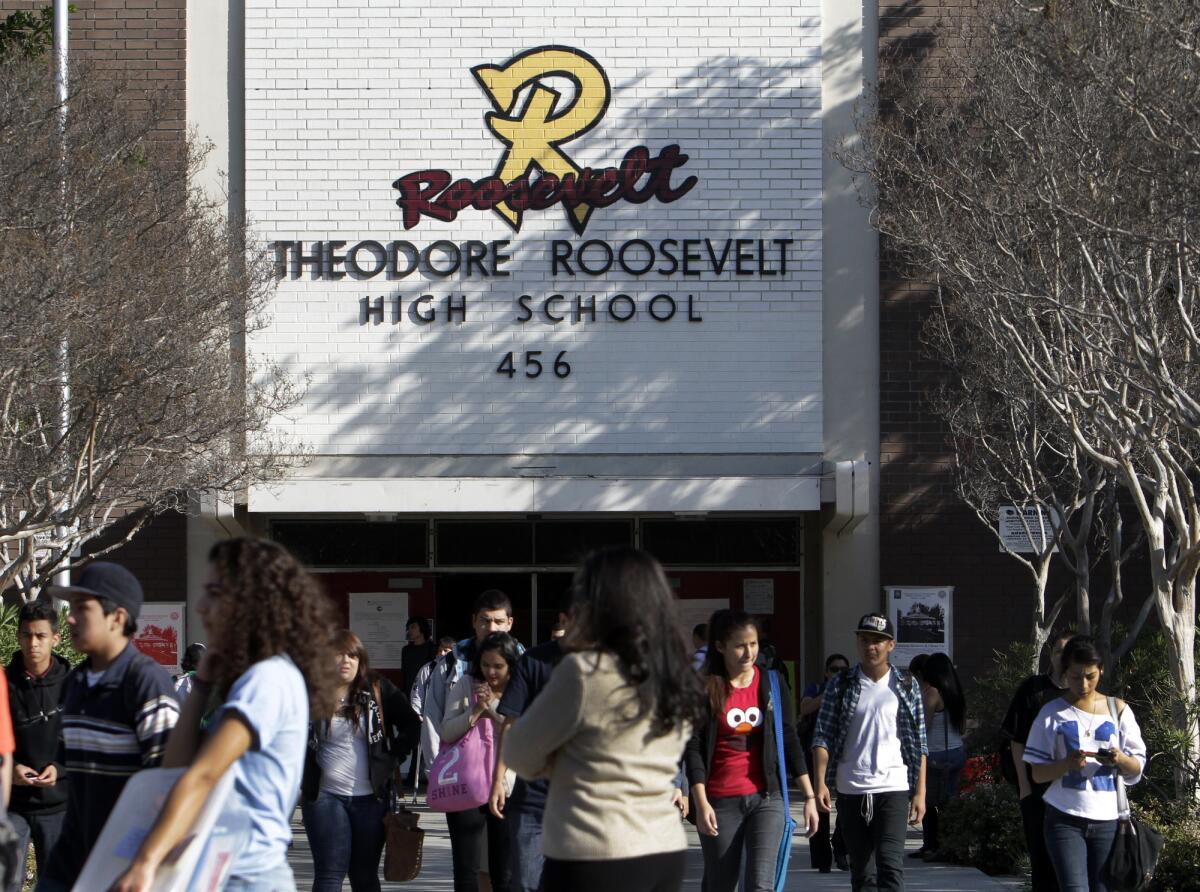$50-million effort launched to reinvent the American high school

Students leave Roosevelt High School in 2012.
- Share via
If Jeimy Carrasco had $50 million, she would remake Roosevelt High School into a place of smaller classes and stronger student-teacher relationships, and put an end to droning lectures and dry textbooks in favor of more active learning.
Adriana Meza at Lincoln High would bring in salad bars and more college counselors. Viviana Martin Del Campo would remove police from Central High and bring in more restorative justice coordinators trained to help students change their behavior, not just punish them.
The ideas of these three Los Angeles students could become more than wishful thinking. They now have a chance to add their voices to a $50-million national competition to redesign American public high schools that was officially launched Wednesday by Laurene Powell Jobs.
XQ: The Super School Project is calling on teams of educators, students, civic leaders, artists and others to create high schools that foster dynamic learning, critical thinking, intellectual flexibility, collaboration and other skills needed for the modern world. The current high school model was developed a century ago to produce factory workers and hasn’t changed much since, said Powell Jobs, whose husband, the late Steve Jobs, fostered out-of-the-box thinking at Apple.
Under the project, finances would be awarded to pay for at least five new schools over five years. One key focus will be to narrow the yawning gap in academic achievement between students of different racial, ethnic and economic backgrounds, said Russlynn Ali, the new chief executive of XQ Institute who formerly served as assistant secretary for civil rights in the Obama administration’s U.S. Department of Education.
The Times’ new education initiative to inform parents, educators and students across California >>
A recent analysis by The Times of new California state test results found the racial and ethnic achievement gap had widened since two years ago, with whites and Asians scoring progressively higher than Latinos and African Americans.
“We cannot build schools of the future unless they serve all students,” Ali said. “We are helping to restore the promise of our public high schools to become the great equalizer they were intended to be.”
Decades of educational research have identified major problems with many high schools, along with proved reforms, according to Linda Darling-Hammond, faculty director of the Stanford Center for Opportunity Policy in Education.
She said that schools of thousands of students who are shuffled from class to class and often tracked based on perceived ability levels have too often become dropout factories. But smaller campuses featuring personal relationships with highly trained teachers and learning made relevant through community projects and career training have produced higher achievement, even in low-income, minority neighborhoods, she said.
Several schools in California have begun making that shift. Augustus Hawkins High in South Los Angeles, for instance, is one of many in L.A. Unified that have organized into small learning communities; Gia Mack, a senior in the campus’ critical design and gaming school, said the structure has produced engaging classes and close relationships with teachers and administrators.
Such changes have helped California overall, and L.A. Unified in particular, outpace the nation in improving its high school graduation rate since 2000, said John Rogers, a UCLA education professor. But most high schools still use outdated models, he and Darling-Hammond said.
“We do know something about what to do, but we have a long way to go,” Darling-Hammond said.
The project, a year in the making, has launched a detailed website providing application materials – the initial design proposal deadline is next February – and more than 250 resources on student learning.
One of the project’s most striking elements is a requirement to include student and community voices in the planning. Ali and other project leaders plan an eight-city roadshow to publicize the project and collect community input. An interactive public installation will feature the history of public education and record ideas to redesign high schools, while a town hall will specifically solicit ideas from students. The roadshow is scheduled to stop in Los Angeles on Oct. 28.
Adriana Meza hopes to be there. The Lincoln High senior has rallied for better health services and rigorous graduation requirements with InnerCity Struggle, an East L.A. advocacy organization. Now she hopes to help create better high schools.
“If we had better high schools, more students would be engaged, excited about academics and graduate,” she said.
Twitter: @TeresaWatanabe
MORE EDUCATION NEWS:
Why kids are missing so much kindergarten
This is why I send my son to private school
L.A. school board ironing out kinks in search process for new superintendent
More to Read
Sign up for Essential California
The most important California stories and recommendations in your inbox every morning.
You may occasionally receive promotional content from the Los Angeles Times.











